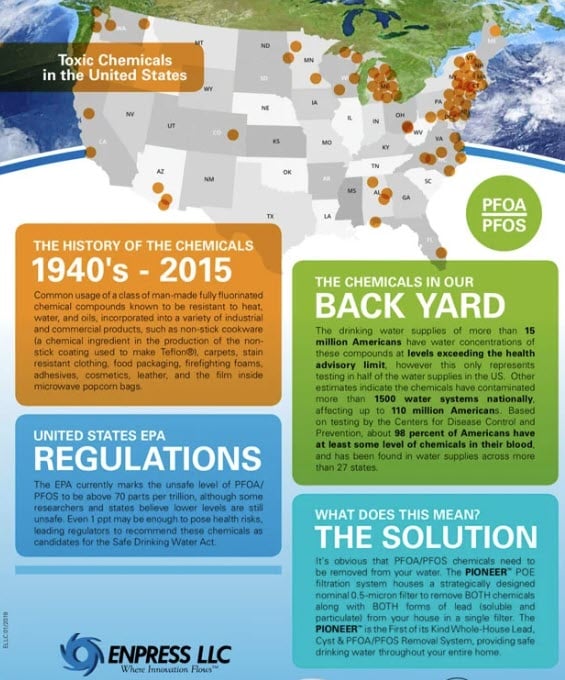PFAS Treatment for Drinking Water: A Guide for Homeowners on Well Water
PFAS Treatment for Drinking Water is needed in many areas of the U.S. and Canada.
Per- and polyfluoroalkyl substances (PFAS) are a group of man-made chemicals that have been used in industry and consumer products worldwide since the 1940s. PFAS are found in a wide range of products, including non-stick cookware, water-repellent clothing, stain-resistant fabrics, and some firefighting foams. Due to their widespread use and persistence in the environment, PFAS contamination has become a growing concern, especially for homeowners relying on well water.
What Are PFAS?
PFAS are often referred to as “forever chemicals” because they do not break down in the environment and can accumulate over time. There are thousands of PFAS chemicals, but two of the most studied and concerning are perfluorooctanoic acid (PFOA) and perfluorooctanesulfonic acid (PFOS). These chemicals can make their way into water supplies, including wells, posing potential health risks to humans.
Health Implications of PFAS
Exposure to PFAS has been linked to a variety of health issues. Research suggests that high levels of certain PFAS may lead to increased cholesterol levels, changes in liver enzymes, decreased vaccine response in children, increased risk of high blood pressure or pre-eclampsia in pregnant women, and increased risk of certain cancers, such as kidney and testicular cancer.
PFAS in Well Water
For homeowners on well water, the risk of PFAS contamination is particularly concerning. Unlike municipal water systems, which may have treatment processes in place to reduce PFAS levels, well water is often untreated and directly consumed. This makes it crucial for well owners to be aware of PFAS and take steps to ensure their water is safe.
Testing for PFAS
The first step in protecting your home from PFAS is testing your well water. Many states and local health departments offer resources or can direct you to certified laboratories that perform PFAS testing. Regular testing is essential, as PFAS contamination can occur over time or suddenly due to changes in nearby land use or industrial practices.
Treatment Options for PFAS

Fortunately, there are effective treatment options available for removing PFAS from drinking water. Based on the latest research and guidelines from the Environmental Protection Agency (EPA) and other authoritative bodies, the most effective treatment methods include:
- Granular Activated Carbon (GAC): GAC filters are effective at adsorbing PFAS compounds from water. They are commonly used in both point-of-entry systems, which treat all the water entering a home, and point-of-use systems, which treat water at a single tap.
- Ion Exchange Resins: These resins can capture PFAS molecules, removing them from the water. Ion exchange systems are particularly effective for water with a mixture of PFAS compounds.
- Reverse Osmosis (RO): High-pressure RO systems can remove PFAS by forcing water through a semipermeable membrane, leaving contaminants behind. RO systems are highly effective but may require more maintenance and are typically used at the point of use.
Implementing PFAS Treatment for Drinking Water
When considering a treatment system for PFAS, it's important to consult with water treatment professionals who can recommend the most suitable option based on your specific water quality and needs. Regular maintenance and monitoring of the treatment system are crucial to ensure it continues to effectively remove PFAS from your water.
Can PFAS be absorbed through the skin when showering?
PFOA can be absorbed through the skin, but the extent to which this occurs and the associated health risks are less well understood compared to ingestion. When it comes to showering or bathing, the main concerns are:
- Inhalation of Aerosols: During a hot shower, water vapor can carry PFOA, which can be inhaled. This can be a more significant exposure route than dermal absorption.
- Dermal Absorption: Although PFOA can penetrate the skin, the rate and extent of absorption are generally considered to be lower compared to ingestion. However, prolonged and repeated exposure could potentially lead to significant absorption over time.
Current research indicates that while dermal absorption of PFOA can occur, it is typically not the primary route of exposure. The most significant health risks associated with PFOA are linked to ingestion, which is why the focus is usually on drinking water contamination.
For those concerned about exposure through showering or bathing, using water filtration systems that can remove PFOA can help mitigate this risk. This can include point-of-use filters for drinking water and whole-house filtration systems for overall water supply.
Conclusion
The presence of PFAS in well water is a significant concern for homeowners, but with proper testing and treatment, you can protect your family's health. By staying informed about PFAS and taking proactive steps to mitigate their impact, homeowners can ensure their well water remains safe and clean for years to come.
For more information on well water treatment solutions and to explore options for protecting your home from PFAS and other contaminants, contact us at support@cleanwaterstore.com.
Useful external links regarding PFAS Treatment for Drinking Water
- US EPA – PFAS Explained
- Description: The Environmental Protection Agency (EPA) provides an overview of per- and polyfluoroalkyl substances, known as PFAS, including their uses, health effects, and EPA's actions to address them.
- Link: https://www.epa.gov/pfas/pfas-explained
- National Institute of Environmental Health Sciences – Perfluoroalkyl and Polyfluoroalkyl Substances (PFAS)
- Description: This page offers information on the health effects, exposure routes, and the history of PFAS use in consumer products and industry.
- Link: https://www.niehs.nih.gov/health/topics/agents/pfc
- U.S. Food and Drug Administration – Per- and Polyfluoroalkyl Substances (PFAS)
- Description: The FDA provides information on PFAS in the context of food safety, including their chemical properties, sources of contamination, and the agency's efforts to monitor and assess the risk.
- Link: https://www.fda.gov/food/environmental-contaminants-food/and-polyfluoroalkyl-substances-pfas
- Centers for Disease Control and Prevention – Per- and Polyfluorinated Substances (PFAS) Factsheet
- Description: The CDC offers a factsheet on PFAS, detailing their use, potential health effects, and the CDC's role in monitoring exposure to these chemicals.
- Link: https://www.cdc.gov/biomonitoring/PFAS_FactSheet.html
- US EPA – Per- and Polyfluoroalkyl Substances (PFAS)
- Description: This comprehensive EPA page on PFAS includes information on the agency's regulatory actions, research, and guidelines for addressing PFAS contamination.
- Link: https://www.epa.gov/pfas















